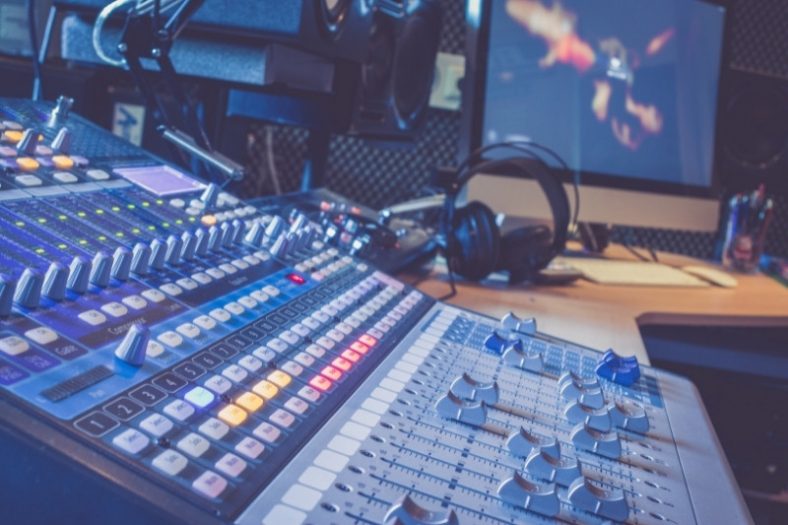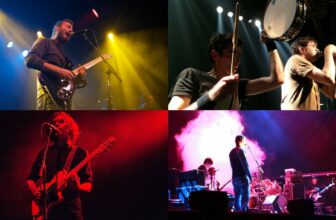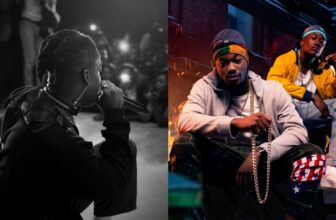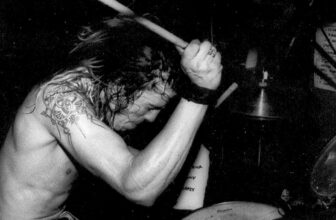What is Lo-Fi Music?

Lo-fi music is music that features imperfections such as low-quality recording, background noise, and tape distortion. These elements are often used deliberately to create a retro, analog, or warm sound. Lo-fi techniques have inspired genres such as folk, indie rock, and instrumental hip hop.
Lo-fi music started when home recording was made possible. Artists working outside of the professional studio environment used equipment such as reel-to-reel tapes and four-track recorders to make albums at home. Due to a general lack of resources, these albums had a distinctively rough, noisy, and hissy sound.
The early experiments of lo-fi music ended up inspiring new generations of artists. By the ’90s, many successful musicians started making lo-fi not out of necessity but because they enjoyed the way it sounded. Today, the term is mostly associated with a particular style of lo-fi hip hop that’s very popular on YouTube.
Contents
The history of lo-fi music
It would be tempting to assume that all low-fidelity music is lo-fi music. However, that’s not the case. When you listen to a recording by great blues and folk artists from the 40s, it does sound distinctively lo-fi. Yet, this happens merely because the professional recording studios of the time were still very archaic.
What distinguishes lo-fi music from old music is the fact that lo-fi artists work, purposely or not, in makeshift studios with equipment that’s far from being the best recording technology available. In other words, they’re working far below their time’s standard, away from the professional recording studio.
The outsiders: the origins of lo-fi music
Throughout the ’60s and ’70s, established artists such as Brian Wilson and Paul McCartney recorded demos and albums at their home studios, which were decent but not extremely well-equipped. Wilson made secret bedroom tapes in his Bel Air mansion and McCartney recorded his debut solo album using a portable multitrack recorder. These are often cited as examples of early lo-fi music; however, they don’t exactly capture the spirit of the true lo-fi pioneers: the outsiders.
Outsider musicians are loners. They usually perform and record music alone, they don’t have access to professional recording studios (unlike Wilson and McCartney), and they are rarely involved in their local music scenes. Most crucially, though, they enjoy making their music at home from start to finish.
Dubbed “the godfather of home recording,” the American multi-instrumentalist R. Stevie Moore is one of the great outsider musicians of all time, and arguably the most influential early figure of lo-fi music.
Other great outsider artists known for their home-recorded, lo-fi records are Jandek and Daniel Johnston. Jandek is a mysterious folk singer from Houston, Texas who’s self-released over 40 home-recorded albums and never gives interviews. As for the late Johnston, he was a cult hero who put out some of the loveliest, roughest songs in town. His life and work are discussed in the documentary “The Devil and Daniel Johnston.”
Alternative rock: when lo-fi becomes cool
Music in the ’80s was easygoing, cleanly recorded, and radio-friendly. It was only natural that the ’90s gave way to a counterculture movement that was almost the exact opposite. Alternative rock went from underground to mainstream, and everybody fell in love with the inherent sadness, gritty sound, and punk attitude of grunge and slacker rock.
From a lo-fi music perspective, the alternative rock of the ’90s mattered because it normalized the idea that “bad-sounding” records can be better than “good-sounding” records. When artists such as Nirvana and Beck made it to the top, they did so with purposely lo-fi songs. The production style of the seminal “Nevermind” is emblematic of this. It’s rough, dry, and almost unprocessed: a clear contrast to the mixing style of the ’80s, with its vibrant synth patches and reverberated snare drums.
The leaders of the alt-rock movement of the ’90s wanted to capture the “authenticity” of music, and they found much inspiration in lo-fi. Kurt Cobain himself once famously wore a Daniel Johnston shirt and was familiar with the work of Jandek. Stephen Malkmus’ Pavement wanted their records to sound as authentic as possible, and they’re still often viewed as the ultimate lo-fi rock band. To some music critics, lo-fi rock was essentially grunge but with all the low-fidelity elements turned up a notch.
The alt-rock revolution of the ’90s was key in promoting the notion that musical imperfections are cool. This helped to popularize the idea that being lo-fi is another creative choice, as crucial as the chords and melodies used in a song. It also changed the mindset of mixing/mastering forever: suddenly, it wasn’t about making a record sound ‘as good as possible’; it was about making a record sound ‘in a certain way’.
MPCs and DAWs: high-fidelity lo-fi music
When electronic music came into the mix, lo-fi music gained endless new possibilities. Iconic producers such as J Dilla and Nujabes started experimenting with beats that included lo-fi textures like vinyl crackles, ambient noises, and deliberate distortion. Sampling was also a big part of this.
The big lo-fi explosion, though, happened when the DAW (digital audio workstation) stepped into the scene. Inspired by the MPC-driven beats of J Dilla, bedroom producers all over the world suddenly needed nothing but a laptop to create a track from start to finish. Unlike R. Stevie Moore or Daniel Johnston, electronic musicians didn’t ‘have to’ make lo-fi (you can produce a studio-quality track with any decent DAW), but they did anyway!
Different from lo-fi rock, lo-fidelity electronic music subgenres such as hauntology or vaporwave aren’t characterized by their roughness and dry production. On the contrary, some of these tracks are extremely detailed and very carefully produced; paradoxically enough, they make for high-fidelity lo-fi music. What makes hauntology and vaporwave lo-fi is the recurrent use of timbres and techniques such as harmonic distortion, tape modulation, and slowed-down samples (as in cassettes).
Lo-fi electronic music has been popular since the start of the 2010s, but it never quite stepped into the mainstream spotlight. Even though many people have heard of vaporwave, for example, the genre has always been an Internet cult sensation first and foremost. It’d all change, of course, when lo-fi hip hop appeared on YouTube.
Lo-fi hip hop: beats to relax/study to
The history of lo-fi music is long, extremely complex, and ever-transforming. But it ends (for now) with the subgenre most people think of when they hear the word “lo-fi:” lo-fi hip hop, also known as chill-hop, or, if you’re not that much into music tags, beats to relax/study to.
Lo-fi hip hop is a style of instrumental hip hop music that relies heavily on low-fidelity samples, slowed-down timbres (as in vaporwave), downtempo beats and grooves, slow and low-frequency bass lines, and soothing piano melodies. It was mainly popularized via YouTube (and through live streaming channels in particular) and branded as ambient/background music. Even though most people can’t name a single lo-fi hip-hop artist, numerous YouTube lo-fi playlists have hundreds of millions of views.
It’s fair to say that, if “beats to relax/study to” was just one man or woman, he or she would be one of the most famous musicians on the planet. There are a few notable single producers in the genre, though. According to the website RateYourMusic, Knxwledge, potsu, and tomppabeats are among the best-known lo-fi hip-hop artists in the world.
Lo-fi hip hop is influenced by some hip hop and electronic-music subgenres from the 2000s. In addition to the aforementioned J Dilla and Nujabes, lo-fi hip hop beats are inspired by the grooviness of jazz-rap, the mellow sounds of downtempo, the loose drumming style of wonky, and the offbeat feel of trip-hop.
This popular music genre is also characterized by its imagery. Most lo-fi YouTube playlists feature images inspired by popular anime. Rain is also a popular theme, and so is the notion of staying warm and cozy inside during a day of bad weather. Like the music itself, lo-fi hip hop’s visual universe tends to evoke feelings of warmth, coziness, nostalgia, and relaxation.
What makes lo-fi hip hop so popular?
Lo-fi hip hop is extremely popular because it’s a soothing style of background music everybody can enjoy. It’s the perfect muzak (i.e., elevator music) of our generation; it’s pleasant and non-distracting without the perks and disadvantages of other background music genres.
While ambient music tends to be overly monotonous and non-progressive, lo-fi hip hop is groovy and fast (individual songs tend to have one to three minutes). While new age music is largely based on esoteric and even religious themes, lo-fi hip hop is urban and unpretentious. And while cool jazz can be overly complex and off-putting, lo-fi hip hop is catchy and predictable.
The influence of hip hop can also help to explain the popularity of the genre. Hip hop is one of the most popular styles of music in the world right now, which means lo-fi hip hop is more familiar to most listeners than other genres of background music. Whenever a hip hop fan needs music to study or work, he or she will probably go for a lo-fi hip hop playlist, not for distracting hip hop music with lyrics.
Finally, lo-fi hip hop is also popular because it’s a well-known Internet trend. After all, YouTube’s algorithm has been generously promoting lo-fi hip hop playlists to its 2.6 billion active users since the early ‘2010s. With that many potential listeners, it’s no wonder the genre has stepped into the mainstream in a way no other Internet-based style of music ever did.
How to make a lo-fi hip hop beat
The main elements of a lo-fi hip hop beat are a soothing melodic loop, a slow hip-hop beat, a simple bass line with lots of low frequencies, background field recordings, and analog-inspired effects.
To make a lo-fi hip-hop beat, you should start by finding a two to four-bar loop that just sounds right. You can do it yourself by coming up with an interesting chord progression on the piano; alternatively, you can grab a sample from an old recording.
You can find excellent material virtually anywhere, but I’d recommend music styles such as solo piano, exotica, or easy-listening music from the ’50s. Slowing down any sample is always a must; you’ll not only change it from the original but also add some texture and grittiness. You can do so easily by dragging the loop to any sampler instrument.
The beat itself (i.e., the drums) is probably the hardest part, but also the most entertaining. Find inspiration in styles such as slow, conscious hip-hop, trip-hop, downtempo, etc.—anything groovy, not too fast, and not too straight (a four-on-the-floor rock beat won’t work). For the drum sounds, old-school hip-hop one-shot samples work wonders: just remember to add some dirtiness to the snare (Ableton Live’s Erosion is great for this) and to go for a deep kick that matches your bass line. These tips to make software drums sound real should come in handy.
The bass line should be simple and even deeper than the kick. Some sidechain compression can help you to “glue” the bass line to the drums. As for the bass sound, it shouldn’t be too complex. Sometimes, a simple sine wave played at a very low octave should do the trick. You can add some saturation to make it stick through the mix and get some harmonics.
When you have your beat ready, it’s time to spice things up with some low-fidelity sounds and effects. Background field recordings can instantly add that “beats to relax/study to” feel to a song. Pouring rain is the ultimate classic and works just fine, but it might be a bit of a clichè. You can get creative with your field recordings and even make your own using a field recorder, but keep in mind lo-fi hip hop beats are more urban-inspired than nature-inspired (avoid stuff like sounds of the jungle).
Once you have some nice background noises filling up the empty spaces in the mix, it’s time to put some analog-inspired plugins to use and experiment with different textures. Tape modulation, vinyl distortion, and cassette emulators always work wonders. If used correctly, saturators and exciters are great for adding some edge to the drums. A good reverb on an aux track can also improve the overall vibe of a lo-fi hip-hop beat.
Summary
Lo-fi may have started as a bad word, the name you’d give to a poorly-recorded song. But thanks to pioneering outsider musicians, home recording equipment, the ’90s alt-rock scene, and the invention of the DAW, it is now a sound that inspires countless artists.
“Mistakes” in art do tend to be incorporated into the art itself, and that’s exactly what happened with lo-fi. Gritty, noisy, and dusty textures will continue to inspire musicians to come up with new genres and challenge outdated music conceptions. Right now, we’re living in the heyday of lo-fi hip hop, but who knows what lo-fi has in store for us next?





